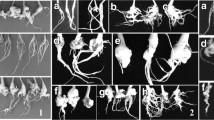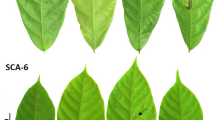Abstract
Inoculation experiment was made for 15 poplar species to determine their resistance toMarssonina brunnea by the agar leaf-dise technique and the water-culture shoots technique. The results show thatPopulus simonii andP nigra var.thevestina are very suseeptible to the disease:P. davidiana andP. koreana are slightly resistant to the disease:P. ussurrensis has high resistance, and the others remain moderate resistance. Experiments are also made for healthy leaves to analysis the inorganic element content and water content. And the results show that the contents of Fe and Ca are remarkbly negatively related to the resistance of poplars toMarssonina brunnea.
Similar content being viewed by others
References
Spiers, A. G. 1978. An agar leaf-Dise Technique for Sereening poplars for Resistance toMarssonina. Plant Disease Reporter, 62(2): 144–147.
Spiers, A. G. 1983. Host Range and Pathogenicity Studies ofMarssonina brunnea. Ear. J. For Path. 13: 181–196.
Spiers, A. G. 1986. Studies of Microconidia ofMarssonina brumea and Apothecia ofDrepanopeziza tremulae. Ear. J. For. Path. 16: 65–82.
Author information
Authors and Affiliations
Additional information
(Responsible Editor: Sun Yueqi)
Rights and permissions
About this article
Cite this article
Yu, X., Cunti, X., Haifeng, L. et al. Study on resistance of poplars toMarssonina brunnea . Journal of Forestry Research 8, 231–234 (1997). https://doi.org/10.1007/BF02875011
Issue Date:
DOI: https://doi.org/10.1007/BF02875011




